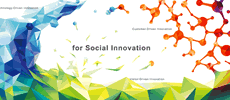Contribution[Part 2]New Ethics and a Return to the Roots of Ethical Capitalism (3 of 3)
Highlight
In the second article in Part 2 of this series, I used photographs and accounts from the time to set the tone for recounting how Hitachi, Ltd. emerged from the early years of Hitachi Mine, using it as a real-world example of ethical capitalism in practice. Also evident in this story is the toil and struggle that many people endured along the way. While the task is far from simple, the tale offers many insights into the rewards that come with effort.
The times we live in are characterized by volatility, uncertainty, complexity, and ambiguity (VUCA). In such a world, what should we do to sustain ethical capitalism alongside ongoing innovation?
This is the question that I aim to address here, touching also on core aspects of research and development.
After first reviewing successful examples of the roadmap-based linear approach to research and development, as exemplified by the Apollo Project, I will reference further examples to look at why disruptive innovation demands a different approach.
From this will emerge a fresh view of what ethical capitalism entails. The reason for doing so is that, as covered in my earlier articles, our conventional ethics have their origins in human-centric habits and customs. Having entered a new geologic epoch, the Anthropocene, ethics itself needs to make an about face, transforming it into a system that gives primacy to the natural environment that sustains human life. If we do so, however, the familiar human-centered form of ethical capitalism would fail to seize the opportunity for a more universal future direction. Instead, what is needed is a “jinen” capitalism, one that is based on a new ethical system built on the idea that humans are symbiotes living (“tomo-iki”) as part of the natural environment (“jinen”)*.
Jinen is an inherently Eastern conception of nature and is different from the Western concept that was translated into Japanese as “shizen” in the early Meiji era. In this article, I will refer to it as “nature-centered capitalism,” expressing it this way to contrast with the conventional concept of “human-centered capitalism.”
- *
- There exists in economics the idea of natural capital. It extends the concept of capital to encompass all natural resources required for human economic activity, including forests, soils, water, the atmosphere, biodiversity, and biological resources. Jinen capitalism is a new concept that includes humans as part of this natural capital.
In this third article in Part 2 of this series, I intend to consider the role played by art as a manifestation of this new capitalism, bringing harmony to the world. As my aim is to edge closer to a new way of thinking, I hope you will forgive the small leap this involves.
Exceeding Limitations of Roadmap-based Linear Research
The Apollo Program (1961-1972) for manned exploration of the moon by the US National Aeronautics and Space Administration (NASA) is recognized as a classic example of success achieved through a variety of research and development management practices. It was a national project with a clear goal, as articulated by the well-known words of J.F. Kennedy (1917-1963): “We choose to go to the moon.” (see Figure 1).
The reason for the project’s success, I believe, was that setting a very clear objective from the outset allowed a variety of different research and development practices to work effectively. The recent Moonshot Research and Development Program (a major project launched by Japan’s Cabinet Office), for example, took inspiration from the Apollo Program. Indeed, I expect that much of the research and development that takes place around the world is modeled on Apollo.
Examples can also be found in publicly available details of Hitachi’s past research and development work and in its future plans. These include the history of the Hitachi Central Research Laboratory, and the decade-old and present Hitachi research and development plans, which are available on the web, and also in more recently published development plans*.
The first technology developed by Hitachi in-house was the 5-hp induction motor, described in the second of the Part 2 articles (with credit for the underlying principle of operation going to Nikola Tesla). As reported in various sources, induction motors currently account for about 50% of electricity consumption, both globally and in Japan, indicating that Hitachi was on-target in its choice of early development, plans, and goals. As noted in the earlier article, this departure point on Namihei Odaira’s roadmap continues to shine brightly today, more than 100 years later.
I also feel, however, that a deeper concept was at work, one that transcended the roadmap approach.
- *
- 1. M. Hoshiai, “History and General Introduction of the Hitachi Central Research Laboratory,” 20th Anniversary of Establishment, Hitachi Hyoron (1962)
2. S. Azuhata, “R&D strategy —Strategies to accelerate new growth—” (2010).
3. N. Suzuki, “Research & Development Strategy: For global innovation leadership” (2022).
USA’s Apollo Program was completed successfully by NASA.
Daniel Goldin, the nineth and longest-tenured Administrator of NASA, serving in that role from 1992 to 2001, subsequently turned his attention from space science to brain science, paying a visit to my laboratory in Kokubunji, Tokyo. It was my good fortune to be able to learn about how research and development was managed in the Apollo Program from a primary source. In return for our talk, Administrator Goldin introduced me to Gerald Maurice Edelman (1929-2014), winner of the 1972 Nobel Prize in Physiology or Medicine and Director of The Neurosciences Institute, a research institution in the USA that studies consciousness. This led to my having the opportunity to visit the institute’s campus in La Jolla where we continued the discussion.
Dr. Edelman adopted an approach to research and development that was diametrically opposed to the roadmap method. In his youth he was a virtuoso violinist. Most research facilities were located in the vicinity of a large music hall with excellent acoustics. It seemed to me that all of the researchers I talked to had capabilities that excelled in thinking and action. Along with robotics and artificial intelligence (AI), Administrator Goldin and Dr. Edelman were also interested in the study of human consciousness. Whereas consciousness had for a long time been a major topic in philosophy, psychology, aesthetics, and art, it was now possible to approach the subject from the fields of natural science and technology.
After space, I got the impression that they saw the next major frontier in science as being the conscious world of modern human beings, the inner space of the brain*.
- *
- Dr. Edelman has numerous publications on the subject of consciousness, including “The Remembered Present: A Biological Theory of Consciousness” (Basic Books, New York, 1990).
From Space to the Brain, Thence to the Study of Consciousness
The study of consciousness has a long history. Francis Harry Compton Crick (1916 to 2004), one of the discoverers of DNA, embarked on work treating it as a topic in natural science in around 1990*.
- *
- F. Crick, and C. Koch, “Towards a Neurobiological Theory of Consciousness,” Seminars in Neuroscience (1990)
At around the same time, the mathematical physicist Sir Roger Penrose (92 years old at the time of writing) adopted an approach based on quantum physics. However, this is not the sort of study that lends itself to a roadmap. When Professor Penrose, as a mathematical physicist, proposed a quantum theory of consciousness, he was misunderstood for a time. That he was recently awarded a Nobel Prize in Physics (in 2020), albeit for entirely different work, will no doubt be fresh in many people’s minds.
Professor Penrose serves as further evidence that discovery and invention represent discontinuous transitions. This, in turn, points to the need for a cautious and steady approach that involves in-depth study, with an entirely new methodology in place of the roadmap.
Beginning in the 1990s, I have been making steady progress on fundamental studies undertaken with Professor Michael I. Posner (born 1936) as part of a global brain research project of the Organization for Economic Co-operation and Development (OECD), treating this work as an area of applied research. Professor Posner uses the mechanism of human attention as a means of engaging in rigorous basic research into consciousness*.
- *
- Learning Sciences and Brain Research (OECD): A global brain research project on learning sciences and brain research run by the OECD from 1999 to 2010. The North American block was led by Michael Posner, the European Block by Christopher Ball [replaced midway by the young Stanislas Dehaene (born 1965)], and the Asian and Oceanian Block by Masao Ito. My own involvement was at the project-wide level, participating on the OECD side as a member of the international consultative committee. I also coordinated the Japan team project on the brain science of lifelong learning in partnership with the Institute of Physical and Chemical Research (RIKEN).
Figure 1—US Apollo Program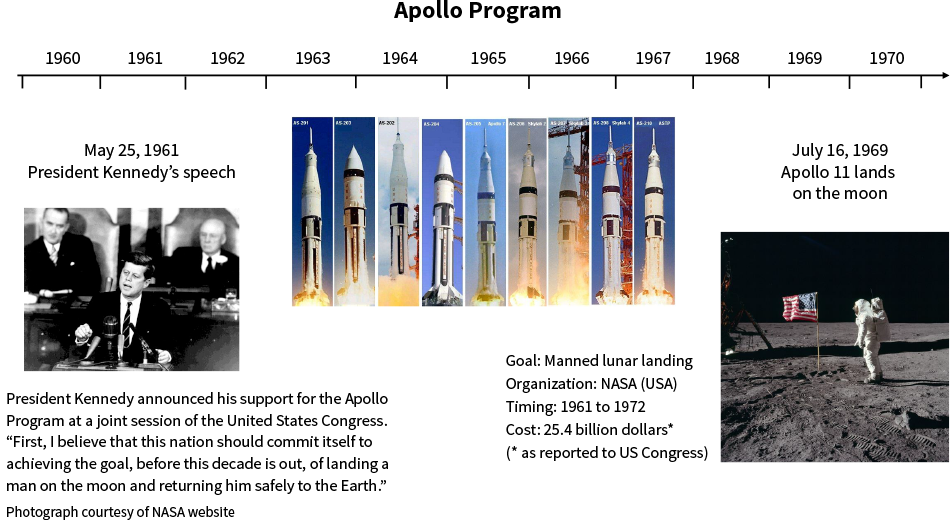 The historic Apollo Program began with a 1961 speech by US President John F. Kennedy. He announced a plan to send a human being to the moon within 10 years and to bring them safely back to Earth. This was accomplished by Apollo 11 in 1969. The plan was devised in great detail with the roadmap laid out on multiple levels and continuously revised to indicate how each new problem that emerged would be dealt with.
The historic Apollo Program began with a 1961 speech by US President John F. Kennedy. He announced a plan to send a human being to the moon within 10 years and to bring them safely back to Earth. This was accomplished by Apollo 11 in 1969. The plan was devised in great detail with the roadmap laid out on multiple levels and continuously revised to indicate how each new problem that emerged would be dealt with.
Figure 2—Image of Nerve that has been to Space and Back and Astronauts Photographed Shortly after Return to Earth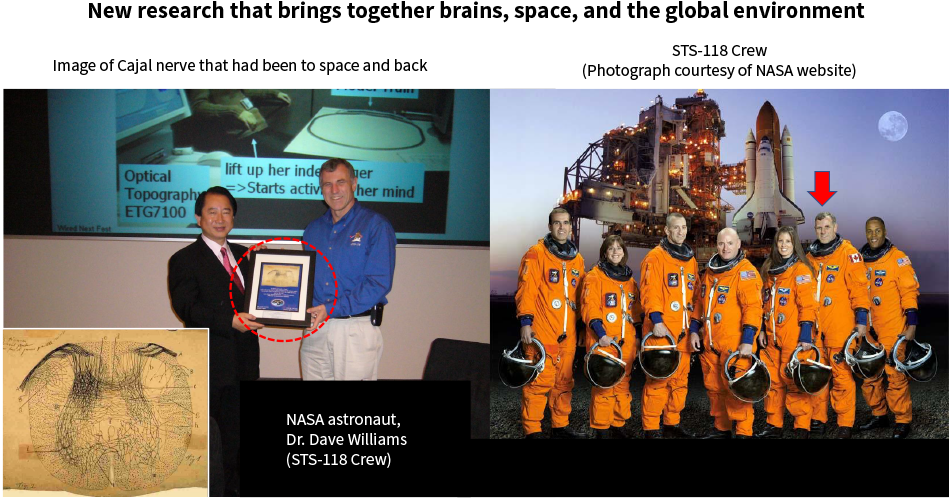 When Wired NextFest 2007 was held in Los Angeles, I received a visit from NASA astronauts who had only recently returned from space. I was presented with a framed photograph of a Cajal nerve that had been taken into space by Dr. Dave Williams, who had proposed joint research on the topic of “space and the brain” and was both an expert in brain- and neuro-science and a practicing doctor. Aware of this, the Japan Aerospace Exploration Agency (JAXA) also commissioned me to undertake joint research and I had the opportunity to talk with Chiaki Mukai and other Japanese astronauts.
When Wired NextFest 2007 was held in Los Angeles, I received a visit from NASA astronauts who had only recently returned from space. I was presented with a framed photograph of a Cajal nerve that had been taken into space by Dr. Dave Williams, who had proposed joint research on the topic of “space and the brain” and was both an expert in brain- and neuro-science and a practicing doctor. Aware of this, the Japan Aerospace Exploration Agency (JAXA) also commissioned me to undertake joint research and I had the opportunity to talk with Chiaki Mukai and other Japanese astronauts.
Historically, the success of the Apollo Program led to the roadmap approach to large research and development projects being adopted globally. While this approach is highly valuable in fields where fundamental research has achieved a certain level of maturity, it is difficult to apply to innovation, including new discoveries and inventions for which the foundations have yet to be fully worked out. Even when it is used, it tends to result in merely formalistic management.
Discoveries and inventions are both discontinuous transitions. This is because the undertaking of state-of-the-art research at the leading edge of its field is just that: an art.
Accordingly, the NASA-style roadmap approach to research management has its pitfalls. It has become commonplace in science and technology policy-making to look ahead 30 years, from 2020 to 2050 for example, specifying the research work to be undertaken and drawing up a roadmap. Moore’s Law, an empirical rule of thumb, is well known in the field of semiconductors. As shown in Figure 3, it states that the number of transistors per unit area able to be fabricated on a chip doubles every two years.
Figure 3—Moore’s Law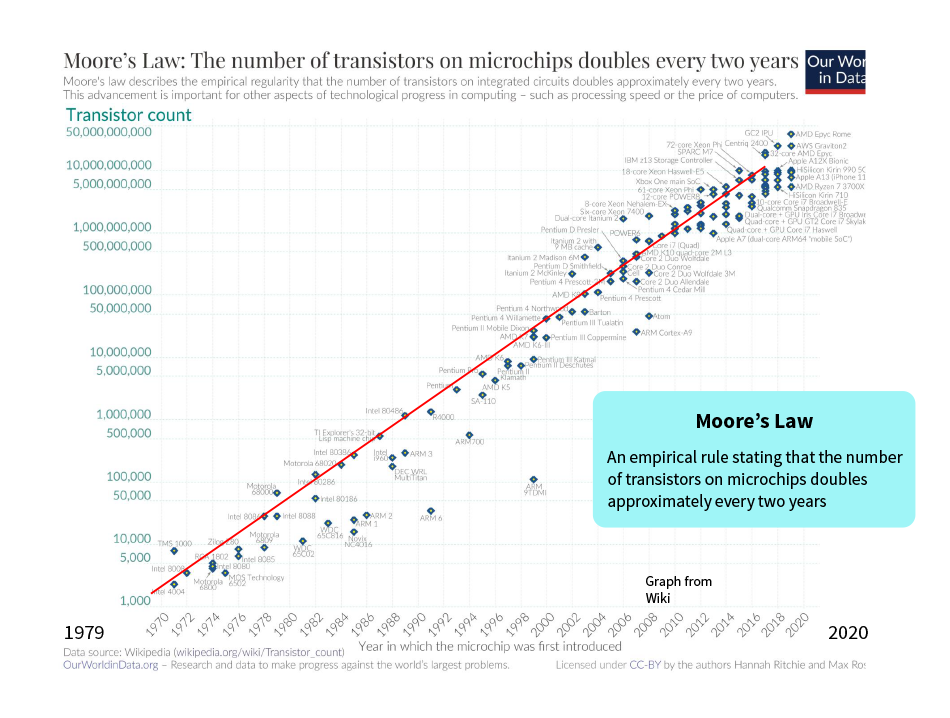 Moore’s Law is an empirical rule of thumb that states that the number of transistors on microchips doubles approximately every two years. This rule has continued to hold true for a long period of time. The clarity this provides regarding the objectives for the next decade means that a step-by-step roadmap works well, just as it did with the Apollo Program. The achievement of clear goals can be accomplished by a linear approach to research and development that involves work on fundamentals, applications, and implementation.
Moore’s Law is an empirical rule of thumb that states that the number of transistors on microchips doubles approximately every two years. This rule has continued to hold true for a long period of time. The clarity this provides regarding the objectives for the next decade means that a step-by-step roadmap works well, just as it did with the Apollo Program. The achievement of clear goals can be accomplished by a linear approach to research and development that involves work on fundamentals, applications, and implementation.
Unfortunately, it is not always so well suited to work where new concepts are used to create new markets.
Meanwhile, if you set out to anticipate the future 30 years hence from the standpoint of 2020, a sense of what this entails can be had by looking back 30 years to the circumstances in 1990. Consider technologies taken for granted in 2020, such as the smartphone and YouTube: was their popularity predicted back in 1990? The software developed by the European Organization for Nuclear Research (CERN) that underpins the world-wide web (WWW) was released in 1993. That is, when roadmap-based research and development misidentifies the correct applications for a technology, people fail to realize its significance and the benefits are lost. Japan, in particular, has reason to reflect on this outcome.
In celebrating its 100th anniversary in 2019, the Royal Swedish Academy of Engineering Sciences (IVA) both looked back at the past century and engaged in energetic debate on the science and technology of the century to come. The event included a presentation from the Massachusetts Institute of Technology (MIT) on the past productivity of AI (the cumulative value of its economic outputs). Despite being a highly topical field, the cumulative output from the field of AI remained very close to zero for many years. Moreover, far from being limited to AI, this is something that can be said of numerous new fields, especially general-purpose technologies.
That is, once industry wakes up to the value of a technology, investment begins to pick up pace and with this comes a rapid rise in the value of sales. Roadmap-based research and development also gets underway. Certainly, within the wider field of AI, generative AI as exemplified by ChatGPT went on to become a social phenomenon last year in 2023. No doubt many readers will still recall how it burst upon the scene over a matter of mere months. Nevertheless, as noted above, it was a leading researcher from MIT who pointed out how this works, doing so objectively and using real-world AI as an example back at a time when most people had yet to pay any attention.
Column 1
TOKKEN Special Research Project Enhanced by Roadmap
TOKKEN is a research and development methodology devised internally by Hitachi, Ltd. It applies to the latter stages of the linear research and development model and has also been adopted overseas. As a practice that has arisen organically out of a need, I see it as being very trans-disciplinary.
The methodology features milestones along the roadmap and is able to overcome what is known as the “valley of death*,” those stages in a project that involve creating new products unlike any that have existed before or the implementation of innovative technologies with large potential markets (Schumpeter’s disruptive technologies).
I have had personal experience of putting TOKKEN into practice on three separate occasions in my role as the de facto leader on product development projects for magnetic resonance imaging (MRI). A stake is placed in the ground by committing in advance to a delivery date for the first product (typically in two or three years’ time). Offsetting this, the full support of the company is mobilized until the TOKKEN process is complete. The general manager of the division responsible for the product concerned serves as the TOKKEN senior administrator and TOKKEN Conferences are held to maintain strong momentum behind the project, attended by the managers of the relevant workplaces (including the head of the hospital) as well as by the managers of the relevant laboratories from across Hitachi (in my case the business division was the Instruments Division at Naka Works and the laboratories included the Central Research Laboratory, Hitachi Research Laboratory, Systems Development Laboratory, and Production Engineering Research Laboratory).
- *
- Valley of death: The phenomenon whereby a research and development project falters just as the findings of fundamental research are at the point of being transformed into a practical technology due to the many obstacles that need to be overcome prior to real-world deployment, or is abandoned prior to completion due to a lack of funding.
Column 2
Hitachi’s Practice of Ochibo-Hiroi (Gleaning) and “Putting Words into Action”
Ochibo-Hiroi (gleaning) is a system into which Dr. Kumeo Baba devoted considerable effort late in his life, in the 1950s. In contrast to Namihei Odaira, who was always looking ahead to the future, I see Dr. Baba as someone who confronted head-on the many practical problems posed by the real world. As failures are inevitable when developing technology, he gave thought to how everyone involved in product defect incidents could work together to prevent reoccurrence. Given that there is no such thing as an absolutely reliable technology, the question of how the rate of incidents can be reduced to a level that is acceptable to society is one that is integral to the enterprise of manufacturing. Although built on the principle of dealing with problems leniently, on the basis that failure is the mother of success, it was in practice a sternly rigorous process. This was because it was predicated on a customer-first mentality that treated the causing of problems to customers as an unequivocal failure.
My own three-fold experience of the TOKKEN methodology as the de facto leader described above has left me with an indelible memory of Ochibo-Hiroi used at a company-wide level from the relevant vice presidents on down. Hitachi’s Henjin-kai (an association of current and former Hitachi employees who have doctoral degrees) takes its name from the observation that people with doctorates tend to be a little odd (henjin in Japanese). Dr. Baba, on the other hand, referred to himself as a “daihenjin” (more than usually odd). Whereas Namihei Odaira is a classic example of someone who believed in action before words, Dr. Baba was all about putting words into action. Although I first considered this latter expression (“yugen jikko” in Japanese) to be rather inelegant, on an occasion when I was asked to write something for the company’s daily pad calendar, it was, after considerable deliberation, those words that I chose, appending a commentary. What I realized was that these were the words that mattered in the workplace. Ever since then I have strived to put them into practice. In development projects that involve large numbers of people, it is only after clear pronouncements are repeatedly made that the entire organization is able to be of one mind. Moreover, it is because having the bravery to speak up represents the first step. I see it as a phrase that has arisen from a proper appreciation of the workplace.
There is an institution in Europe (the Netherlands) called The Institute of Brilliant Failure, and I have had discussions with its director, Professor Dr. Paul Louis Iske. Initiatives that address failure in new ways are becoming more essential than ever.
Why is Art Essential to Progress in Science and Technology?
The brain has evolved in layers around the core of the brain stem. The process of evolution has encased the centrally located brain stem, which sustains life, first with the archicortex (the oldest part of the cerebral cortex that deals with survival) and then with the neocortex (the part of the brain that deals with surviving better). (See Figure 11 in the first article of Part 2.)
The knowledge and skills that are so valued by modern humanity are deeply interwoven with the cerebral neocortex, the final structure to evolve. However, the desire to put knowledge and skills acquired through education and learning to use in practical tasks arises from the archicortex beneath it. In other words, it is only when inner desires or emotions manifest that the knowledge and skills of the neocortex are put to use. These desires or emotions are also directly tied to what constitutes artistic expression.
In “The Theory of Economic Development” (1912), Joseph A. Schumpeter (1883-1950) described innovations as “new combinations” in which a new concept is created through the combination of two disparate concepts. This requires a strong desire. Moreover, a comfortable life robs people of their desire to create, something that he saw as a problem for the USA, having the potential to bring down capitalism.
The essence of innovation lies not in the use of roadmaps as a management technique, but rather it is underpinned by more primordial desires and emotions. There is a very fine line between this and art. As a result, a new movement is arising in which artistic activities are being applied to fields of science and technology.
There are many theories about the origins of art.
Cultural evidence of works that clearly involve the use of art to articulate abstract concepts can be found in diverse forms along the historic path followed by modern humans (a term frequently used to refer to Homo sapiens sapiens, the only species in the genus Homo, having evolved in Africa up to 60,000 years ago before moving farther afield). Cave paintings that depict animals are one example. Plato and Aristotle also addressed the question of art. While activities such as sculpture were thought of in Ancient Greece as depictions of nature (including humans), the more recent emergence of aesthetics has given rise to the concept of art as we currently know it.
The great writer Leo Tolstoy (1828 to 1910) addressed the question of what art is from a perspective different from that of academics in the field of aesthetics. He grappled earnestly with the topic in his book “What is Art?” (1897). On reading it, one can see him introspecting on the subject and in some ways becoming even more confused. In fact, Tolstoy criticized many forms of art, even taking a critical view of his own literary works.
Looking at it from a brain- and neuro-science perspective, I believe Tolstoy’s thinking can be summarized by describing art as a dance, performance, or other work done by a person to share deep emotions with other people. The emotion conveyed by art can be thought of as invariably combining both sensibility and reason (see Figure 4)*. Modern art, for example, includes works that emphasize rational aspects (the discovery of concepts), and modern music, too, has in certain instances taken this rationality (conceptual aspect) to an extreme, as in the work “4’33” by John Milton Cage Jr. (1912-1992). This work involves the performer appearing on stage for a predetermined period of time during which they perform nothing at all.
- *
- The definitions of “reason,” “understanding,” “sensibility,” and “intelligence” differ between fields and traditions. While it is only right that each field should define these terms as suits them best, they are used loosely when dealing with more than one field at a time.
While the fields of artistic expression can be divided into the fine arts (which emphasize space) and music (which emphasizes time), delivering such expression in the form of words gives us works of literature. Music, for example, takes the form of variation over time while maintaining “intelligence and sensibility” in dynamic equilibrium, as in Figure 4. While this dynamic equilibrium differs depending on the composer or the times in which a piece was composed, it also invariably changes during the performance. Meanwhile, what is vital is that the emotion of the composer and the performer be shared with others, namely the audience for the performance. Assuming no human intervention, we would not describe a stone polished by the actions of a river over a long period of time as a work of art, however attractive it may look. Nor would we describe a beautiful rainbow as art, no matter how much it moves us to see it. It is only when both a creator and an audience are present that something becomes a work of art. A piece that an artist has produced solely for themselves might possibly be thought of as an artwork in waiting, but it is not a living artwork. I believe that art happens only through the mediation of human actions. This has parallels with quantum mechanics, where entities do not manifest until they are observed.
Figure 4—Art’s Roots in Harmony between Intelligence and Sensibility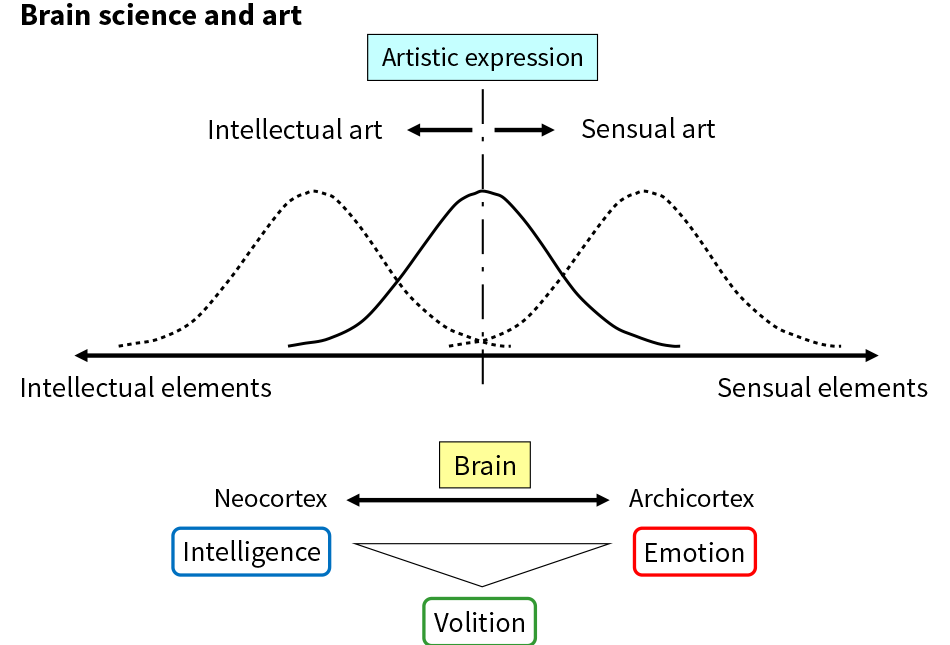 The modern human brain is said to embody “intellect, emotion, and volition,” where intellect (with rationality being the aspect unique to humans), emotion (referred to as affect when including non-human animals), and volition manifest in separate functional areas. While these have undergone continuous change through the process of evolution, two capacities that emerged as discontinuities, unique to modern humans, are language (an aspect of intelligence) and empathy (an aspect of emotion), including sympathy as a higher-level form of empathy.
The modern human brain is said to embody “intellect, emotion, and volition,” where intellect (with rationality being the aspect unique to humans), emotion (referred to as affect when including non-human animals), and volition manifest in separate functional areas. While these have undergone continuous change through the process of evolution, two capacities that emerged as discontinuities, unique to modern humans, are language (an aspect of intelligence) and empathy (an aspect of emotion), including sympathy as a higher-level form of empathy.
Art typically sets its intellectual and sensual elements in a state of dynamic equilibrium, with the relative proportions varying over time with each situation or scene.
Cultural and Artistic Facilities in the Early Years of Hitachi
Facilities for culture and entertainment were built during the early years of Hitachi Mine for the enjoyment of the people who lived in the area. The first to be completed was the Motoyama Theater opened in 1913 (shown on the top left of Figure 5). This was at a time when Hitachi was in only its third year and still occupied its original sogyo goya workshop.
The design of the Daioin Theater commenced in 1916. In 1917, the Kyoraku-kan was constructed thanks to the efforts of the mine’s technical staff (the old original building is visible on the right of the photograph shown in the top right of Figure 5). The Kyoraku-kan has since been gifted to Hitachi City and rebuilt as the Hitachi Budo-kan, in which form it remains in use (bottom left of Figure 5). It is a nationally designated important cultural property. Modeled on the Kabuki-za Theatre in Tokyo, it had a capacity of about 1,000 people and was equipped with a rotating stage and a passageway for stage access. Its opening was marked by three days of kabuki performances by a troupe of more than 50 performers featuring Gennosuke Sawamura IV (1859-1936) and Sadanji Ichikawa II (1880-1940).
The theater was also equipped to show movies, initially in the form of simple moving pictures, followed in the post-war period by a state-of-the-art projector that was able to present the latest movies. In addition to the staging of kabuki and other traditional drama with invited performers from Tokyo and Osaka, the theater also hosted performances of Western music and cultural presentations, including on occasion performances by notable singers or dancers from the time. As such, the theater became a venue for the enjoyment of people from the mine and surrounding areas and a place where elementary and middle school children could naturally experience arts and culture.
Figure 5—Artistic and Cultural Facilities from the Early Years of Hitachi Mine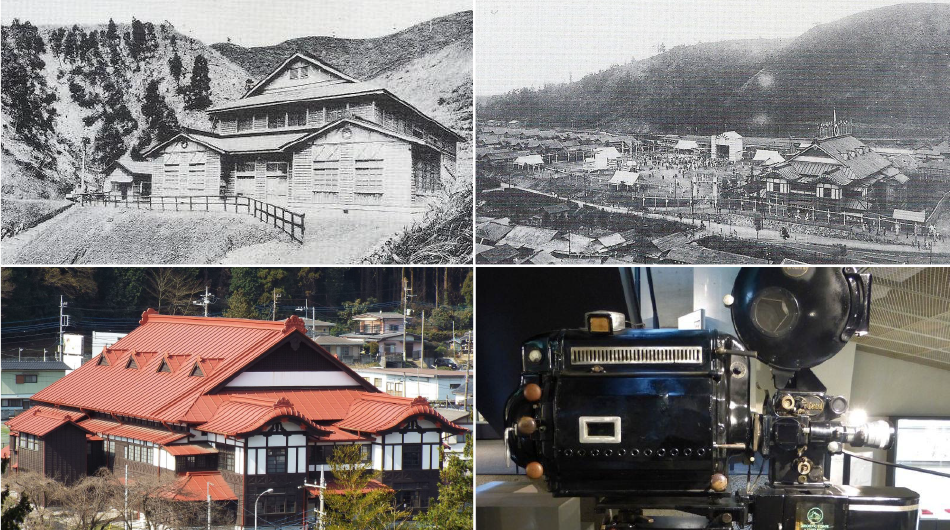 The photographs show the Motoyama theater (top left), the Kyoraku-kan in its early days (top right), and another past image of the Kyoraku-kan that in the present day is used as Hitachi Budo-kan (bottom left). The building is unusual in that it was designed by the factory designers and constructed at the factory. The design took inspiration from the old Kabuki-za Theatre in Tokyo. Another feature was the installation of large vents in the ceiling for ventilation, just like in the factory. The photograph on the bottom right shows the state-of-the-art projector that was subsequently used at the Kyoraku-kan and that is now at the Nippon Mining Museum.
The photographs show the Motoyama theater (top left), the Kyoraku-kan in its early days (top right), and another past image of the Kyoraku-kan that in the present day is used as Hitachi Budo-kan (bottom left). The building is unusual in that it was designed by the factory designers and constructed at the factory. The design took inspiration from the old Kabuki-za Theatre in Tokyo. Another feature was the installation of large vents in the ceiling for ventilation, just like in the factory. The photograph on the bottom right shows the state-of-the-art projector that was subsequently used at the Kyoraku-kan and that is now at the Nippon Mining Museum.
https://www.kyorakukan-tsudoi.com/ in Japanese.
From Kyoraku-kan to Odaira Hall
On the 50th anniversary of the founding of Hitachi (in 1960), Odaira Hall was constructed to serve as another genuinely multi-purpose facility in addition to the Kyoraku-kan. It was located on top of a hill in Hitachi City overlooking the ocean. Records from the time of the opening indicate that, while there had apparently been talk of an orchestra, it was ultimately decided to feature a bunraku puppet show. Chikara Kurata (1889-1969), the second president of Hitachi, Ltd., gave the event its title of “Koten wo Aiso” (Love for the Classics), and the performance itself featured the puppets of Tsunadayu Takemoto VIII (1904-1969), the shamisen of Yashichi Takezawa X (1910-1976), and the gidayu-bushi music of Wakadayu Toyotake X (1888 to 1967). All of these performers were recognized in Japan as living national treasures (known as “Important Intangible Cultural Properties”). President Kurata stated that, “The performance of Tsubosaka Reigen-Ki [the puppet show] was a highlight. I was moved by how the performers devote such dedication and single-mindedness to showing us Japanese performing arts, regardless of when and where they are performing.” This shows that it was not only Hitachi’s founding president who was deeply acquainted with the arts, but that our second president also had a deep understanding.
(Hideaki Koizumi, Danjuro Ichikawa, “Brain Science and Kabuki — in Heart of Child,” Kousakusha Co., Ltd., 2012; Hideaki Koizumi, “Japanese Traditional Performing Arts,” NHK, 2014).
While the decision to feature Japanese music at the opening of Odaira Hall reflects the outlook of Hitachi’s senior management of the time, history also records their interest in Western music and how this was put into practice.
Around the same time as Odaira Hall was opened, they also installed a top-of-the-line concert grand piano, known as an “Imperial,” made by Bösendorfer and imported from Austria. The Imperial is recognized as a flagship among the world’s pianos and was designed in according to the preferences of the pianist Ferruccio Busoni (1866-1924). By installing such a piano, Odaira Hall in Ibaraki could host performances by pianists from around the world, just like in Tokyo and Osaka.
In 1961, a year after its opening, the venue hosted the conductor, pianist, and composer Leonard Bernstein (1918-1990) together with the New York Philharmonic Orchestra. The deputy conductor at the performance was a young Seiji Ozawa (1935-2024). (The tour’s Tokyo concert was held at the newly opened Tokyo Bunka Kaikan). This serves as a good example of Odaira Hall’s standing.
I was deeply moved by a performance given on this piano at Odaira Hall by Annie Fischer (1914-1995). I subsequently had the opportunity to speak with her at length, having been invited to visit the Liszt Ferenc Academy of Music should I happen to be in Hungary (which I did some years later).
International Conference Hall at Kyōsō-no-Mori and Bösendorfer Imperial Piano
In an initiative driven primarily by Hitachi CTO Norihiro Suzuki (a former head of the Hitachi Central Research Laboratory and currently Chairman of the Board at the Hitachi Research Institute), the International Conference Hall at Kyōsō-no-Mori (the Baba Memorial Hall) was completed in 2019 and has been equipped to suit the needs of a new era. I have received many inquiries since it was still at the construction stage, and numerous other large international conference centers were being built overseas at the same time. Being of the opinion that the opening needed to convey a message that was unique to Hitachi, I tracked down the aforementioned Imperial piano at the Odaira Memorial Museum and looked into whether it could be relocated to the new facility. Thanks to the efforts and generous assistance of many different people, we were able to obtain the piano, which had been entrusted to the Hitachi General Hospital in Hitachi City, initially on a fixed-term loan*.
- *
- It was decided to demolish Odaira Hall after it suffered major damage in the Great East Japan Earthquake in 2011. The site became vacant in 2016. The historic and venerable concert grand piano was acquired by Hitachi General Hospital, where it fell out of the limelight, being used for hospital concerts. Its relocation to the International Conference Hall at Kyōsō-no-Mori in Kokubunji, Tokyo, was thanks to the efforts of the hospital’s honorary director, Yu-ji Oka, among others.
As I have argued here, I believe that art will need to be given a role of considerable importance in future research and development. I hope this story will help many people to recognize the importance of artistic expression, something that was dear to the heart of Namihei Odaira. In fact, I believe one need only look to present circumstances and past history to see how a devotion to art serves as a measure of how energetically creative research and development are being pursued.
In addition to its world-leading work, the Research Center for Advanced Science and Technology (RCAST) at the University of Tokyo is also now turning its attention to art. Recently, the center was the unexpected recipient of another world-renowned concert grand, this one made by the French piano maker Pleyel et Cie at about the same time as the Imperial. After roughly a year of restoration work, the piano was restored to its previous glorious sound. Meanwhile, the person who called on a number of people, including Alfred D. Cortot (1877-1962), another famous pianist from times past, to choose the best piano in the world at the time and then had it imported for the benefit of art and culture in Japan was none other than Daigoro Yasukawa (1886-1976), the founder of Yaskawa Electric, who Namihei Odaira once invited to work at Hitachi. Yasukawa’s daughter-in-law, Kazuko Yasukawa (1922-1996), herself a pianist, served as a judge at the Chopin Piano Competition and was a professor emeritus at Tokyo University of the Arts. Living in Paris at the time, she launched the search for the world’s best piano by asking her teacher, Lazare Lévy (1882-1964). As can still be seen to this day, the frame of the piano is signed by both Cortot and Lévy.
Figure 6—Final Tuning of Restored Imperial Piano Once Used at Odaira Hall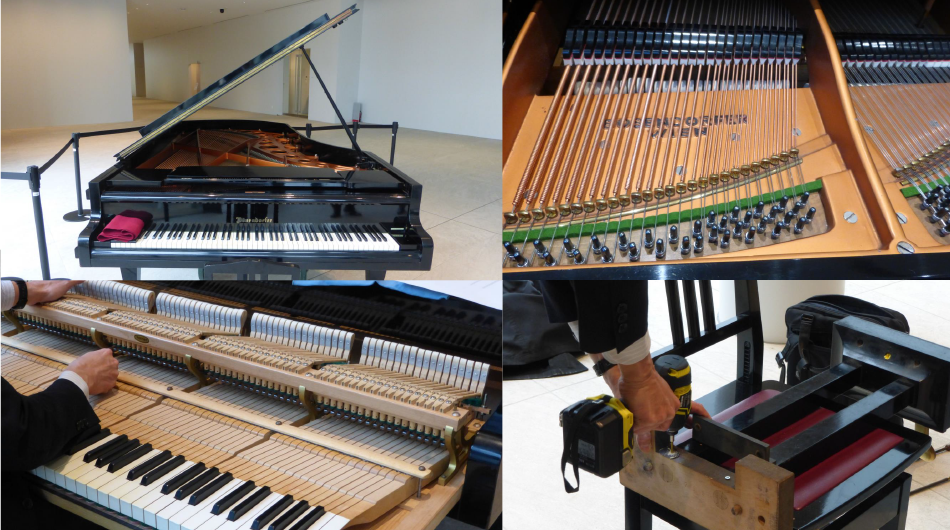 The Imperial piano that is emblematic of Bösendorfer has nine additional keys that extend its range down by a major sixth to C. The piano wire for the low-note strings is wrapped in one or two layers of copper wire, the harmonics of which help to give the piano a superior sound. Although the aging pedals came loose during final adjustment following restoration, a rapid repair was effected with the aid of the prototyping team at the Central Research Laboratory, restoring the instrument’s sound to its original excellence.
The Imperial piano that is emblematic of Bösendorfer has nine additional keys that extend its range down by a major sixth to C. The piano wire for the low-note strings is wrapped in one or two layers of copper wire, the harmonics of which help to give the piano a superior sound. Although the aging pedals came loose during final adjustment following restoration, a rapid repair was effected with the aid of the prototyping team at the Central Research Laboratory, restoring the instrument’s sound to its original excellence.
Inquiries made to Bösendorfer during the restoration indicated that this was the second Imperial piano imported into Japan. With the whereabouts of that first piano unknown, this highlighted just how precious the piano imported by Hitachi was. As shown in Figure 6, the aging pedals detached during the final check after restoration was complete. The prototyping machining shop at the laboratory was enlisted to help, and further repairs were made post-haste.
Figure 7—Restoration and Tuning of Concert Piano at Hitachi International Conference Hall that Once Graced Odaira Hall The Bösendorfer Imperial piano was restored and tuned in readiness for the opening of the International Conference Hall at Kyōsō-no-Mori, located at the Hitachi Central Research Laboratory. Here, the instrument is going through a final check at the hands of pianist Seiko Ezawa, a professor at the Kunitachi College of Music who has a deep familiarity with the “Vienna tone” from playing mostly in Germany and who took first place in the piano division at the Music Competition of Japan.
The Bösendorfer Imperial piano was restored and tuned in readiness for the opening of the International Conference Hall at Kyōsō-no-Mori, located at the Hitachi Central Research Laboratory. Here, the instrument is going through a final check at the hands of pianist Seiko Ezawa, a professor at the Kunitachi College of Music who has a deep familiarity with the “Vienna tone” from playing mostly in Germany and who took first place in the piano division at the Music Competition of Japan.
The pianist Seiko Ezawa, a professor at the Kunitachi College of Music who has also worked extensively in Germany, was called upon to verify that the piano replicated the old-time “Vienna tone” and she closed out a packed schedule at the conference hall opening ceremony with a performance of Ballade No. 1 by Chopin.
Sometime later, when I encountered the Australian ambassador who had attended the event, he expressed his delight by saying how impressed he had been by the concert. Australia boasts a high number of Nobel Prize recipients per capita. Dr. Brian P. Schmidt (born 1967), a recipient of the 2011 Nobel Prize for Physics, puts a strong emphasis on the interaction between art on one hand and science and technology on the other, using the Australian invention of the musical synthesizer as an example.
I believe that emotional engagement also serves as a driver for science and technology, giving rise to new discoveries and inventions. From this, it follows that there is a fine line between art and the wellsprings of innovation, and that losing sight of this is likely to result in organizations that are full of managers well-versed in roadmap management and researchers who only go by the rules. There are numerous examples that show how such organizations end up atrophying.
What Does it Mean for Future Research and Development to be Reliant on Collaboration with Art?
―Symposium Celebrating the 100th Anniversary of the Royal Swedish Academy of Engineering Sciences (IVA)―
It was in February 1920 that Hitachi, Ltd. was formally established as a company in its own right, separate from the Hitachi Mine of Kuhara Mining Company. IVA was established in October 1919, just four months earlier. The 100th anniversary of IVA’s founding served as an occasion to look back on the past 100 years and to talk about the next 100 years to come.
This Northern European academy already engages in considerable co-creation with art. The symposium that marked IVA’s 100th anniversary featured an organic interaction between science and the arts, with musicians giving short performances between lectures and making presentations alongside engineers. Something I was conscious of when attending the event was how art serves an essential role in science and technology as well as in public life. The Karolinska Institutet and its associated hospital are both decorated with works of art, and it is my understanding that the law in Sweden requires public buildings to devote a fixed percentage of the cost of construction to the purchase of artworks. As a result, these facilities are invariably adorned with such works.
Figure 8—Northern Europe United by Science and Technology and Debate on Generative AI Prior to its Emergence in the Public Consciousness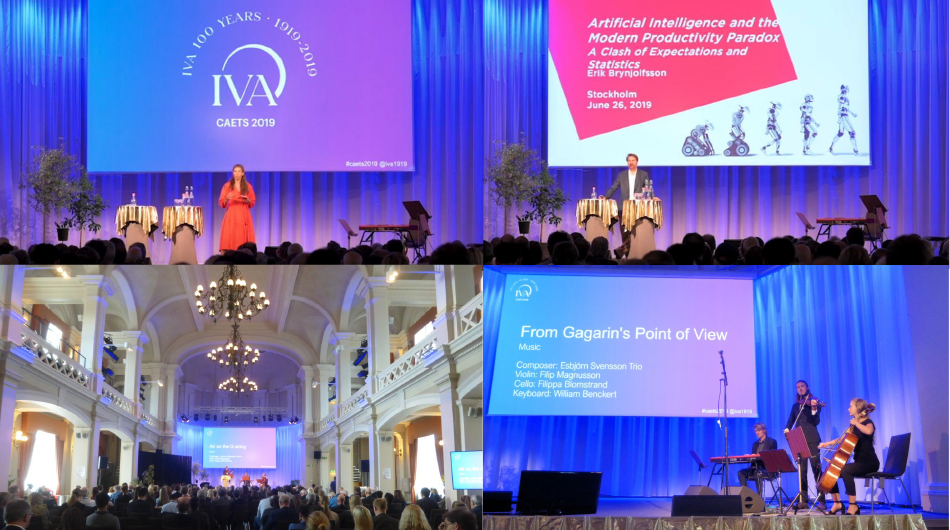 At the annual conference of the International Council of Academies of Engineering and Technological Sciences (CAETS) celebrating the 100th anniversary of the Royal Swedish Academy of Engineering Sciences (IVA), a presentation was given on the importance of generative AI, as of 2019, and on why it had yet to capture the world’s attention (the relationship between research and industry). The presentation was accompanied, before and after, by performances that included a piano trio and solos by cello and violin. The intermingling of art with science and technology is already happening in Northern Europe. The symposium was of very high quality, covering matters that invited everyone involved to reflect on science and technology over the past century and to collectively consider the century to come. (The photographs were provided courtesy of the IVA.)
At the annual conference of the International Council of Academies of Engineering and Technological Sciences (CAETS) celebrating the 100th anniversary of the Royal Swedish Academy of Engineering Sciences (IVA), a presentation was given on the importance of generative AI, as of 2019, and on why it had yet to capture the world’s attention (the relationship between research and industry). The presentation was accompanied, before and after, by performances that included a piano trio and solos by cello and violin. The intermingling of art with science and technology is already happening in Northern Europe. The symposium was of very high quality, covering matters that invited everyone involved to reflect on science and technology over the past century and to collectively consider the century to come. (The photographs were provided courtesy of the IVA.)
In neighboring Finland, Aalto University came into being out of a partnership between the design faculties of the Helsinki University of Technology and the University of Art and Design Helsinki, also incorporating the Helsinki School of Economics and establishing a central role for itself as a university for delivering fresh innovations, as recounted below.
In the USA, meanwhile, MIT runs a program entitled “Music and Theater Arts” out of its humanities, arts, and social science faculties. I was able to hear in detail how this came about and what it signifies from Professor Chuck M. Vest (1941-2013), the 15th President of MIT and the former President of the National Academy of Engineering (NAE). The program’s origins lie with Professor Jerome B. Wiesner (1915-1994), the 13th President of MIT, who was a leader in the US development of radar. He also served as a science advisor to President Kennedy and was an advocate for the Apollo Program discussed above. This arts program has come to be highly valued within MIT. No doubt this is because art is essential to creative science and technology. Professor Vest told me that, rather than musicology, the faculty of music focuses on performance and composition because of the direct contribution that art itself can make to the depth and progress of MIT’s science and technology. The two groups—performers and composers on the one hand, and scientists and engineers on the other—are able to serve as catalysts for one another.
Conference Celebrating the 100th Anniversary of Hitachi’s Founding
A conference to mark the 100th anniversary of Hitachi’s founding was held at the Tokyo International Forum in 2010. Professor Amartya Sen attended from Harvard University in the USA and gave an impressive commemorative speech suitable for such an occasion. Similarly, in a dialogue with Professor Sadako Ogata (1927-2019), a former United Nations High Commissioner for Refugees, we considered what lies ahead for modern humanity in the next 100 years.
I was truly astonished to hear the words “Prince Shotoku” being uttered by Professor Sen as he started in on his lecture. Professor Sen was named by none other than Tagore, the great Indian poet (first Nobel laureate in literature in Asia). When attending Tagore’s school in India, Sen learned about Prince Shotoku’s Seventeen-Article Constitution and developed a deep fascination with Japanese culture.
Figure 9—Cover Page of Hitachi Hyoron Edition Covering Hitachi’s 100th Anniversary Conference and the Anniversary Lecture Entitled, “Japan and the Future of the World”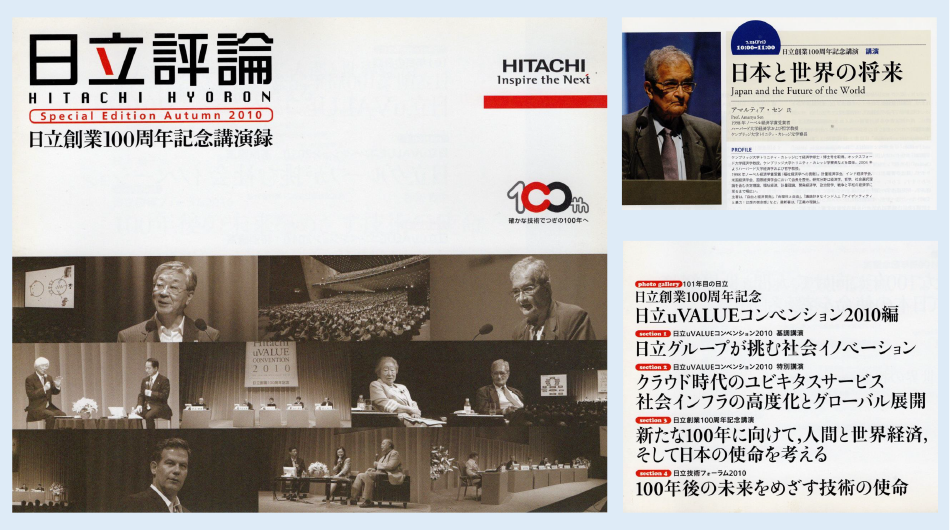 The conference was held in 2010 in various halls of the Tokyo International Forum. The image on the left shows the cover page of the conference proceedings. The three-by-three grid of photographs shows Hiroaki Nakanishi (1946-2021), Hitachi’s 10th president who gave a presentation on the current state of Hitachi (top left), the 100th anniversary speech of Professor Amartya Sen (top right), a dialogue between myself and Hiroyuki Yoshikawa, the 25th President of the University of Tokyo (center left), and a dialogue between Professor Amartya Sen and Sadako Ogata, the 8th United Nations High Commissioner for Refugees (center right).
The conference was held in 2010 in various halls of the Tokyo International Forum. The image on the left shows the cover page of the conference proceedings. The three-by-three grid of photographs shows Hiroaki Nakanishi (1946-2021), Hitachi’s 10th president who gave a presentation on the current state of Hitachi (top left), the 100th anniversary speech of Professor Amartya Sen (top right), a dialogue between myself and Hiroyuki Yoshikawa, the 25th President of the University of Tokyo (center left), and a dialogue between Professor Amartya Sen and Sadako Ogata, the 8th United Nations High Commissioner for Refugees (center right).
Treasuring Harmony
The Seventeen-Article Constitution was, in the account recorded in “Nihon Shoki” (the Chronicles of Japan), composed entirely by Prince Shotoku (also known as Prince Umayado) (574-622) on May 6, 604, during the reign of Empress Suiko. The first article of the constitution calls for the valuing of harmony and has been rendered in various forms in modern Japanese. It also states that arbitrary decisions are to be avoided and calls for an emphasis on debate. It is said to have been a precursor of the provision in the Charter Oath of Five Articles from the Meiji Restoration that calls for holding broad-based assemblies and settling all critical issues by public debate.
The Japanese text of the first article is as follows:
一曰,以和爲貴,無忤爲宗。人皆有黨。亦少達者。以是,或不順君父。乍違于隣里。然上和下睦,諧於論事,則事理自通。何事不成。
Paraphrased in English, it urges us not to dispute unduly and to adopt an underlying attitude of valuing cooperation, entering into in a state of mutual harmony. Each of us possess a partisan spirit and people capable of seeing the big picture are rare. This is why we fail to heed our lords and fathers and why we come into conflict with those around us. If people of both higher and lower station are able to talk harmoniously with one another in good faith, matters will not fail to be dealt with in a reasonable fashion.
The seventeenth and final article represents the foundations of democracy, closing with the following words, which warn us against dictators. I believe this gives us pause to think about the current global situation.
The Japanese text of the final article is as follows:
十七曰,夫事不可獨斷。必與衆宜論。少事是輕。不可必衆。唯逮論大事,若疑有失。故與衆相辮,辭則得理。
Paraphrased in English, it warns that we should not attempt to make big decisions on our own. Always discuss matters with a large number of other people. With smaller matters, we do not necessarily need to consult many other people. When discussing important matters with others, however, we should keep in mind the possibility that we are mistaken. Accordingly, if we talk to a large number of people and get to the bottom of what is right and wrong, the matter will end up being dealt with in a reasonable fashion.
Note that, while it is said that the phrase “treasure harmony” comes from “The Analects of Confucius,” the expression used in that document is limited to the field of manners and as such has a different meaning. One can think of its Japanese expression, “wa wo motte totoshi to nasu,” as being a true product of Japan.
In 1951, when Namihei Odaira’s post-war exclusion from public office came to an end and he returned to Hitachi, Ltd., he made an inscription with the above expression of “Harmony is to be valued, ” and hand towels carrying these kanji characters were distributed to everyone at Hitachi Works. On October 5 of that same year, his life of 77 years came to a close. Copies of these words are to this day still displayed around Hitachi’s many workplaces.
Evolution and Wild Animals
In the second of these Part 2 articles, I wrote about how the human brain carries within it the history of our evolution. Genetic analysis indicates that our species split off from chimpanzees, gorillas, and orangutans some 6 to 7.6 million, 7.6 to 9.7 million, and 15 to 19 million years ago, respectively*.
- *
- Yuichiro Hara, Tadashi Imanishi, and Yoko Satta, “Reconstructing the demographic history of the human lineage using whole-genome sequences from human and three great apes,” Genome Biology And Evolution, 4, (11), pp. 1133–1145, doi: 10.1093/gbe/evs075, (2012).
In a history of life dating back at least 3.8 billion years, less than 8 million years (0.2%) have passed since the modern human brain diverged from that of the chimpanzee, our nearest relative among the other animals. It has recently been determined that modern humans (Homo sapiens sapiens, the only remaining species in the genus Homo) exchanged genes with our extinct sub-species, the Neandertals (Homo sapiens neanderthalensis). The term “modern human” is, I understand, most often used to refer to our species from about 200,000 years ago when we moved out of Africa, where we first emerged. As such, our separation from chimpanzees and gorillas, species we think of as wild animals, was a very recent event on the timescale of evolutionary history. Our brains carry within them a long history of evolution, with most parts of the human brain being shared with those of wild animals. The most conspicuous difference between our brains and those of chimpanzees is the region centered on the frontal pole of the pre-frontal area. Moreover, the difference in genetic makeup between us and wild chimpanzees is said to be about 1 to 3%. It cannot be denied that the difference between human brains and those of wild animals is a fine one. As I have reiterated before, the greatest difference lies in the evolution that has taken place in those functional areas of our brains that deal with language.
According to reliable academic research conducted to date, chimpanzees lack any grammatical capabilities that exhibit the sort of hierarchical structures found in humans. (In various fields, mutations in the Fox-P2 gene have been noted.) Lacking a system of language, chimpanzees are unable to think about the future. They live in the present and on the basis of past experience.
Unlike modern humans, chimpanzees have been unable to form large societies. They form small troupes. As everyone knows, each troupe has an alpha chimpanzee at its apex who serves as its boss. Along with wisdom, the key to becoming the boss is physical prowess, which is to say, violence. This is what it is to be wild, the basis of a chain of life that exhibits a discontinuous continuity whereby wild animals protect their kin and leave their offspring behind after they die.
Modern humans, on the other hand, have evolved not only language but also empathy. Rather than being self-centered, we understand other people’s points of view and sense how they feel inside. This is an area where neuroscience has made recent progress. Our altruism, an attribute rarely seen in wild animals, serves as a stabilizing influence on society. While animals clearly possess their own form of emotion, emotion as we think of it is something that has only arisen in modern humans.
The human equivalent of an alpha chimpanzee is the dictator. The development of democracy by modern humans arose out of concern for others. While this makes it a means of using reason and deep sensibility to suppress instinctive behavior, it can also often result in inefficiencies. The current international situation presents itself with great clarity when viewed from the standpoint of the evolution of life.
Meanwhile, I believe there is an important role to be played by the nations of the East.
Column 3
Origins of Classical Performance Art and the Desire for Peace
Genjiro Okura is a tsuzumi drummer and Grand Master of the Okura School who has been recognized as an Important Intangible Cultural Property. The following account is one I recently learned about from him and a number of other Noh performers belonging to different schools. The story they told me was about how Nestorianism, a form of Christianity different from the Catholicism of Francisco de Xavier (1506-1552), came to Japan from China at the time of Prince Shotoku (574-622), and about Kawakatsu Hata, an advisor of Prince Shotoku [believed to be one of a group of foreigners who had travelled from Jin Dynasty China via Baekje (present-day Korea) to become residents of Japan around the 4th Century, as also recorded in “The Flowering Spirit” by Zeami (1363-1443)]. They also made the point that the Gagaku music of the Imperial court and the Noh theater of the people had a common origin in which both Prince Shotoku and Hata played a part. Kawakatsu Hata’s remains are said to be buried at Osake Shrine on Ikishima Island in the Inland Sea. There is more than one shrine with that name and it is said that “Osake” (大避) is the phonetic equivalent of a different character pair (大闢) that comes from Chinese, and that these characters are in turn the ones used for the name “David” (the King of Israel who features in the Old Testament of the Bible).
Kawakatsu Hata had an involvement in the origins of the Gagaku music of the court and in Noh theatre (in its ancient forms of Sangaku and Sarugaku), and his surname Hata has been incorporated as a middle name in the name used by the above Genjiro Okura in his role as Grand Master of the Okura School.
The important fact in all this is that a naturalized resident of Kyoto married a Japanese person and established a matrilineal society. It has also been said that this was a reason why Japan had so few conflicts with neighboring countries.
The activities of missionaries who, like the Francisco de Xavier mentioned above, came to Japan during the Muromachi period (1336 to 1573) with the aim of spreading Catholicism can be thought of as being fundamentally different in nature to the attempt by Nestorians to assimilate into Japanese culture from the Kofun period (roughly from the middle of the 3rd Century to the 7th Century) to the Asuka period (593 to 710), the latter having become naturalized residents of Japan after being denounced as heretics and forced out of the West (differing in their interpretation of the divinity of Christ and Mary).
If we are to consider the relationship between art and peace, I believe that the history of how Japanese arts emerged in ancient times out of nature worship is especially important. Unfortunately, primary sources that go all the way back to the Kofun period are rare.
The dances and traditional material passed down by many schools designated as Important Intangible Cultural Properties (one example, part of “The Flowering Spirit” that has been preserved by the Kanze School over hundreds of years and kept strictly private, was shown directly to me by Kiyokazu Kanze) as well as the imperial treasures and the Gagaku music enjoyed at the imperial palace, are works of art that I have experienced personally. They leave me with a strong sense of how the heads of these schools have risked their lives to preserve these treasures across generations. The margins of Zeami's original manuscript, “Hisuraba Hana” (secret skill), have been charred at the edges; evidence that, even amid the fires of war, these treasures have been protected at the cost of life*.
Elizabeth A. Gordon (1851-1925), a scholar of comparative religion, was someone who devoted a lifetime to studying Nestorianism and the relationships between Buddhism and Christianity. Her extensive book collection and research work have been gifted to Japan, including Waseda University and Koyasan University. Along with the syncretistic fusion of Shintoism and Buddhism, I believe that her studies of reconciliation with monotheism offer valuable hints on how to put a desire for peace into action.
- *
- Hidemichi Tanaka and Genjiro Okura, “Kawakatsu Hata and the Origins of Noh: A Secret Jew in Japan and the Profundity of Japanese Culture,” Hikaru Land Inc. (2023)
Appendix 1
New University Seeking Role as Platform for Innovation
Here I want to talk about an urgently needed new type of university.
As platforms for innovation, universities play an increasingly important role. While world-leading university reforms are being enacted in various places, including in Northern Europe and China, I am also conscious that moves are happening behind the scenes in Japan toward reforms that combine the respective approaches of Finland and China.
Figure 10—Examples of University Mergers in Finland and China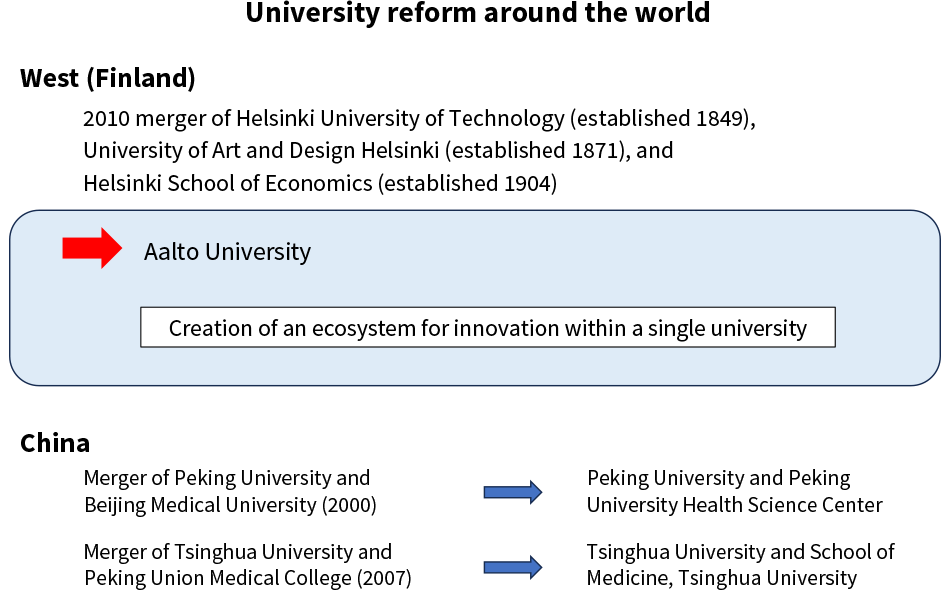 Considerable effort has gone into the consolidation of universities in China, with examples extending beyond what is shown here. In Northern Europe, meanwhile, Finland has attracted attention for a merger of universities that happened 10 years ago, resulting in the world-leading establishment of a new innovation platform incorporating the field of art.
Considerable effort has gone into the consolidation of universities in China, with examples extending beyond what is shown here. In Northern Europe, meanwhile, Finland has attracted attention for a merger of universities that happened 10 years ago, resulting in the world-leading establishment of a new innovation platform incorporating the field of art.
Japan, meanwhile, has the potential to combine both of these approaches.
Figure 11—Faculties at Aalto University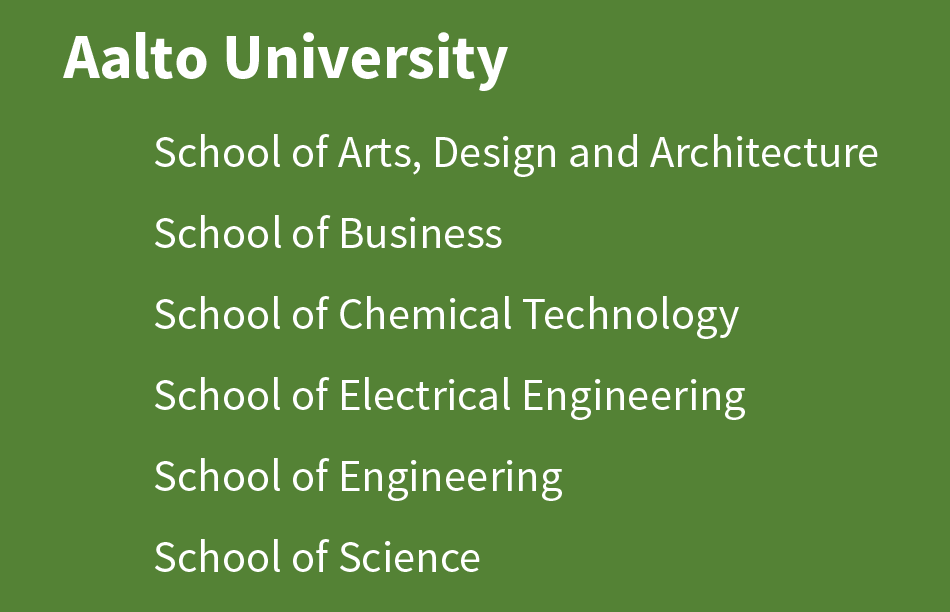 In Finland, three universities with considerably different fields of study merged in 2010 to establish Aalto University as a new innovation platform. In China, mergers took place in the 2000s between medical colleges and universities that lacked a medical school.
In Finland, three universities with considerably different fields of study merged in 2010 to establish Aalto University as a new innovation platform. In China, mergers took place in the 2000s between medical colleges and universities that lacked a medical school.
Figure 12—New University Combination Going Beyond Merger of Three Helsinki Universities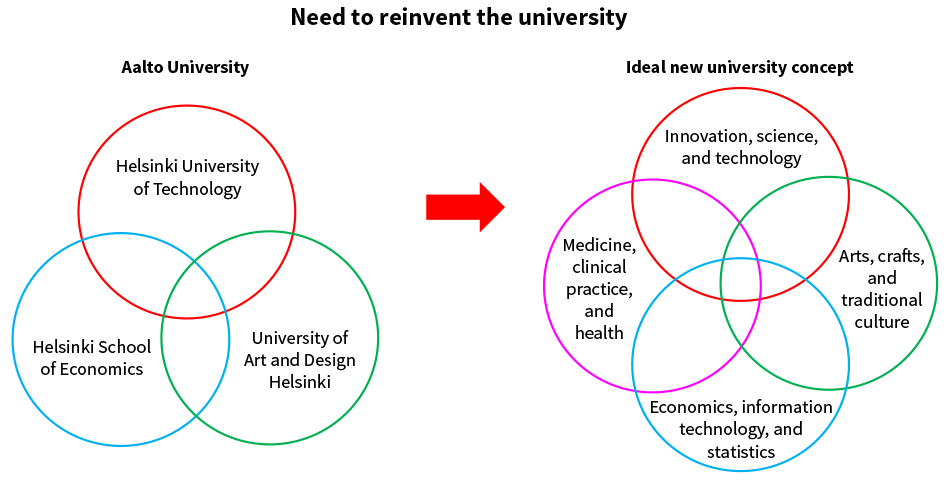 Finland has gained attention for its pursuit of innovation education, with Aalto University, Finland’s second largest, coming into being through the merger of three Helsinki universities (specializing in technology, economics, and art respectively). By merging universities engaged in four different fields of study, namely innovation, science, and technology; medicine, clinical practice, and health; economics, information technology, and statistics; and arts, crafts, and traditional culture, it enables an integrated and holistic approach to challenges that the future will need to address. This new conception of the university is urgently needed.
Finland has gained attention for its pursuit of innovation education, with Aalto University, Finland’s second largest, coming into being through the merger of three Helsinki universities (specializing in technology, economics, and art respectively). By merging universities engaged in four different fields of study, namely innovation, science, and technology; medicine, clinical practice, and health; economics, information technology, and statistics; and arts, crafts, and traditional culture, it enables an integrated and holistic approach to challenges that the future will need to address. This new conception of the university is urgently needed.
The new four-university concept shown on the right of Figure 12 is more than just an idealistic fancy. In Tokyo, for example, four national universities that fit these categories already exist. If the operational funding that these universities receive from the Ministry of Education, Culture, Sports, Science and Technology were to be pooled, it would result in the creation in Tokyo of Japan’s fourth largest university. In practice, this concept for a new four-university institution in Tokyo could be realized through the merger of the Tokyo Institute of Technology, Tokyo Medical and Dental University, Hitotsubashi University, and Tokyo University of the Arts. While such a merger would create a world-class innovation platform, the first step toward this end, I believe, would be to deepen cooperation*.
- *
- While keeping an eye on the progress being made by Aalto University, I have spoken with people from a variety of organizations about the need for university consolidation in Japan (including from the Ministry of Education, Culture, Sports, Science and Technology; the Cabinet Office; legislature; academia; and industry). The feedback I have received from the Cabinet Office has been that the discussion and formulation of proposals on this matter is best conducted by a national academy (for example, the Cabinet Office’s Science Council of Japan and the Engineering Academy of Japan). This may be the case. Recent developments have included the first steps toward working together.
https://www.titech.ac.jp/english/news/2023/068065
Appendix 2
The Conscious World of Modern Humans and Progress toward New Research
In this third article of Part 2 of this series, I have explained why the arts are important for the future of science and technology. If a genuine interweaving and fusion of art with science and technology is to happen, it will require an accurate appreciation of human consciousness. Without it, the concern is that art will serve as no more than decoration for conferences or research and development. In the latter part of this article, I will consider briefly what consciousness actually is, while also presenting an improvised sensory experiment constructed from readily available objects without spending any money. Through this experiment, I hope to raise some questions regarding the opposing ways of thinking represented by Newton and Goethe. What this experiment will show is our ability to see many different colors in light of a single frequency.
Underlying Difference between Newton’s and Goethe’s Concepts of Consciousness
Nikola Tesla, featured in the second of these Part 2 articles, was fond of “Faust” by Johann Wolfgang von Goethe (1749-1832) and said that he could recite all ten thousand or more lines of his poetry. While Goethe is best known for his literary works, of which “Faust” was one, the man himself held that his “Theory of Colors” was his definitive work. In fact, Goethe is also known as the founder of morphology (the study of form) and as a scientist who devised a theory of acoustics. However, he found himself in disagreement with certain views of Sir Isaac Newton (1643-1727), the person who conceived the idea of universal gravitation and who brought the field of mechanics to completion.
Goethe lived somewhat later than Newton and became embroiled in an ongoing dispute with physicists in the period leading up to Gustav Robert Kirchhoff (1824-1887), a scientist known for his work on electromagnetics and spectroscopy. This concerned elucidation of the mechanisms that give rise to the hard problem of consciousness (the problem of phenomenal consciousness or qualia: how does subjective conscious experience arise out of a material brain?). Whether or not generative AIs are capable of consciousness is a question of this type.
Here, I would like to tell you about the results of a simple sensory experiment I conducted while writing this article. To give you a better sense of what this experiment means, I will make a brief digression regarding the relevant parts of the brain that are crucial to information processing.
Figure 13—Conflict between the Outer World of Newton and the Inner World of Goethe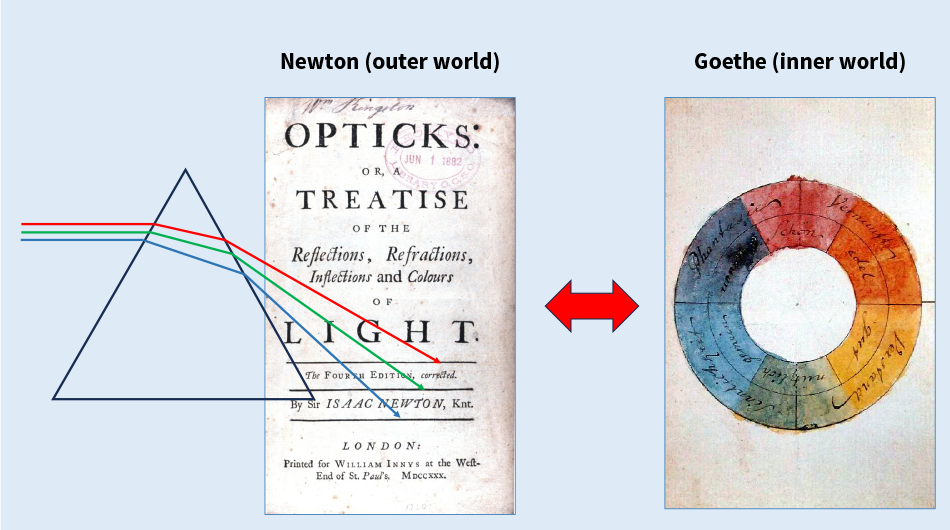 The cover of the fourth edition of Newton’s “Opticks” is shown on the left and Goethe’s color wheel on the right. Newton’s “Opticks” presented the results of experiments that overturned the conventional wisdom of the time: that the true color of light was white and that individual colors arose by refraction. Newton showed instead that, among other things, white is a mixture of all of the different colors and that different colors have different refractive indices, laying the foundations for physics that includes modern optics.
The cover of the fourth edition of Newton’s “Opticks” is shown on the left and Goethe’s color wheel on the right. Newton’s “Opticks” presented the results of experiments that overturned the conventional wisdom of the time: that the true color of light was white and that individual colors arose by refraction. Newton showed instead that, among other things, white is a mixture of all of the different colors and that different colors have different refractive indices, laying the foundations for physics that includes modern optics.
How Brains Process Information, as Exemplified by Vision
For us to perceive what we see, the visual information we obtain from our eyes first goes through the processes shown in Figure 14. The key points are as follows.
- Information propagates through nerves at a speed of at most 200 m/s, far slower than the near-light-speed flow of information carried by electrons. Instead, the basis of information processing in brains lies in massively parallel processing, achieving a sophisticated and highly distributed division of labor.
- For this reason, the external world that is focused by the eye’s lens onto the retina is first completely broken down into separate elements, including lines, their orientation, color, and movement. Following parallel distributed processing, these elements are reconstructed as our inner world.
- This parallel distributed processing does not give rise to consciousness (that is, it occurs below the level of consciousness). It is only in the final stages after this reconstruction has taken place and when processing becomes sequential that a lucid consciousness experience occurs. Because the processing is sequential, we are unable to be conscious of two things at once (e.g., ambiguous figures).
- Reconstructed by taking all elements of the external world apart and putting them back together again, this internal world is not the same as the external world from which it was decomposed. Compounding this are the inevitable differences in how different people perceive the world.
Figure 14—Processing of Visual Information in the Brain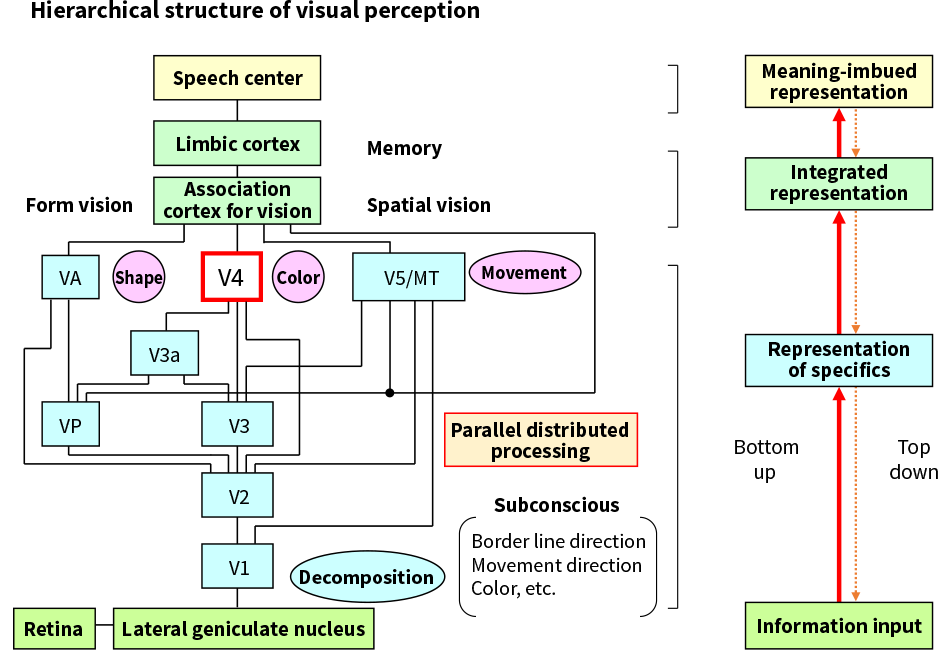 The image of the external world passes through the lens of the eye and is projected onto the retina. After passing through the lateral geniculate nucleus, the image on the retina undergoes parallel distributed processing in the visual cortex in the occipital lobe, breaking it down into lines, their orientation, color, and movement. Finally, this is transformed into an integrated and meaning-imbued representation, namely our inner-world perception of the image of the external world. This is why the external and internal worlds differ between different people.
The image of the external world passes through the lens of the eye and is projected onto the retina. After passing through the lateral geniculate nucleus, the image on the retina undergoes parallel distributed processing in the visual cortex in the occipital lobe, breaking it down into lines, their orientation, color, and movement. Finally, this is transformed into an integrated and meaning-imbued representation, namely our inner-world perception of the image of the external world. This is why the external and internal worlds differ between different people.
Figure 15, meanwhile, shows the results of objective measurement of subjective color perception. The image is taken from experimental results obtained using an early functional MRI machine developed at Hitachi Central Research Laboratory and was acquired during work that led to the discovery that the fusiform gyrus in the brain plays a role in color processing (joint research with the Miyashita Laboratory at the University of Tokyo School of Medicine).
Figure 15—Fusiform Gyrus (Color Center) Activated when Afterimage is Visible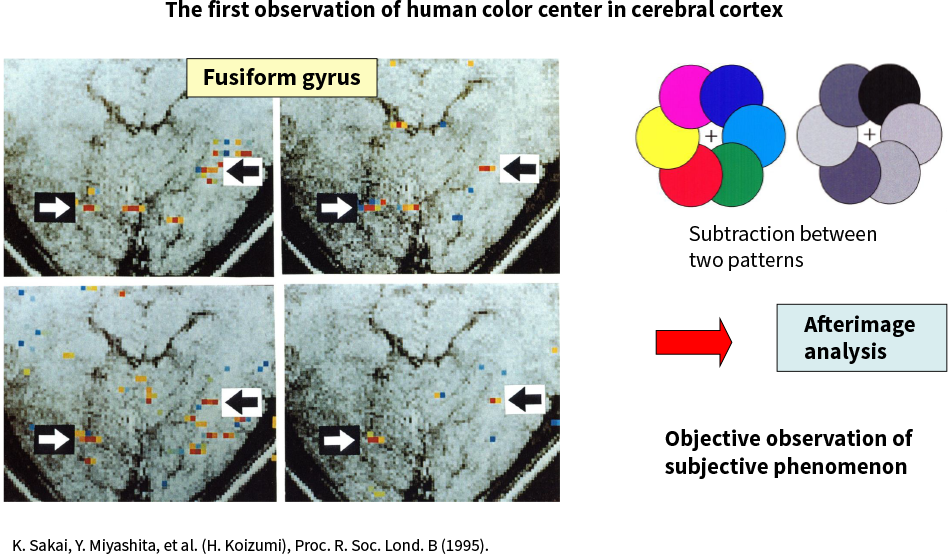 This data comes from the discovery that afterimages (residual images of complementary colors) are processed in the fusiform gyrus of the cerebral cortex [communicated in the same journal by Professor Semir Zeki (born 1940) of the Royal Society]. While it was generally accepted that the fusiform gyrus was involved in color processing, the details were not yet understood. The paper presenting these findings was communicated in The Proceedings of the Royal Society by Professor Zeki, author of the renowned “A Vision of the Brain” ( Blackwell Scientific Publication).
This data comes from the discovery that afterimages (residual images of complementary colors) are processed in the fusiform gyrus of the cerebral cortex [communicated in the same journal by Professor Semir Zeki (born 1940) of the Royal Society]. While it was generally accepted that the fusiform gyrus was involved in color processing, the details were not yet understood. The paper presenting these findings was communicated in The Proceedings of the Royal Society by Professor Zeki, author of the renowned “A Vision of the Brain” ( Blackwell Scientific Publication).
His work, “Inner Vision : An Exploration of Art and the Brain,” translated into Japanese, also represented an attempt to build a bridge between art and science and technology.
Sensory Experiment Bearing upon the Origins of Conflicting Theories of Color
All Colors Can be Seen Even in the Irradiation by a Laser Light with a Single Sharp Line Spectrum
I would like to take time out from writing to demonstrate a practical sensory experiment using only objects to hand at my study desk. The experiment addresses a question that first became a subject of conflict back in the time of Newton’s “Opticks” (first published 1703, 4th edition published 1730) and Goethe’s “Theory of Colors” (1810), although no definitive academic papers exist as far as I know.
In the work toward arriving upon the Polarized Zeeman method based on quantum physics that was touched upon in the third article in Part 1 of this series, the key part of the experimental apparatus was a high-temperature elemental decomposition furnace. This was comprised of an electromagnet made using a coil obtained by disassembling an old magnetron reclaimed from the scrapyard and a filament small enough to fit inside that was obtained by smashing open a bicycle light. The data obtained using this apparatus served as the basis for a number of papers that were accepted by physics journals, including “Applied Physics Letters” and “Physics Letters.” The findings also appeared in the Research News section of “Science.”
When I was invited to work on joint research with the University of California, the equipment that my partners put together to replicate the experiment with a high degree of precision included a large electromagnet that weighed tons and an ultra-high-resolution spectrometer that was about 10 m long.
Likewise when determining the principles behind magnetic resonance angiography (MRA), a technique that has come to be widely used for medical diagnosis of the brain, important roles were played in the experiments by the water from a plastic container suspended from a stepladder placed next to the MRI machine, a rubber hose, and a bucket. When experimental apparatuses built for purposes that are out of the ordinary are designed and built on the basis of common practice, they tend to be over-complicated and take an enormous amount of time to put together.
In this case, the point of the exercise was to perform the experiment using only items found on a study desk. For the monochrome light source, I chose a green laser pointer that happened to be handy (one that I carry with me for use in lectures). The first thing I needed to do was a spectroscopic analysis to verify that it had only one peak in its emission spectrum, which would indicate that its light really was of one color only. For this, I used an ordinary compact disk (CD) of the type used for data storage. A CD engraved with fine grooves acts as a diffraction grating that can project the light onto a white wall as a spectrum. White light from a flashlight reflects back onto a white wall as a beautiful rainbow spectrum. The green light from the laser pointer, on the other hand, only refracts onto the white wall as a single point. This confirms that it really does contain light of only one color (see Figure 16).
The light was directed at a gyroscope after first being scattered and diffused by passing it through two layers of transparent opalescence plastic (in practice, the case for the spinning top). The top carried a pattern made up of partial concentric circles that was invented by Charles Benham for amusement (see Figure 17).
Figure 16—Results of Spectroscopy Performed Using Ordinary Compact Disk as a Diffraction Grating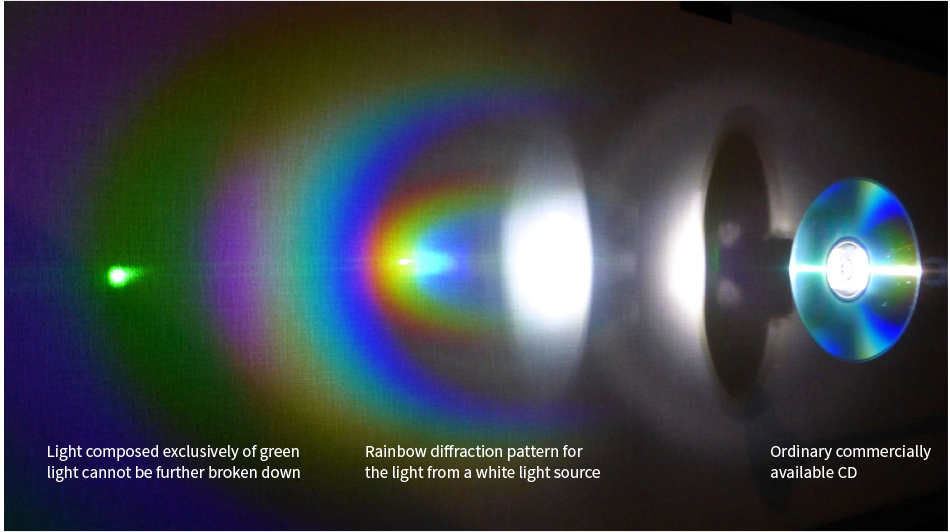 Visible in the center is the diffraction pattern formed by white light from a light-emitting-diode flashlight that has separated into a rainbow of colors. On the left is the diffraction pattern produced by light from the laser pointer, a bright spot representing a green bright-line spectrum. The right of the figure shows the compact disk used as the diffraction grating. The white wall is visible in the background and the light shines onto the compact disk from front-right direction.
Visible in the center is the diffraction pattern formed by white light from a light-emitting-diode flashlight that has separated into a rainbow of colors. On the left is the diffraction pattern produced by light from the laser pointer, a bright spot representing a green bright-line spectrum. The right of the figure shows the compact disk used as the diffraction grating. The white wall is visible in the background and the light shines onto the compact disk from front-right direction.
Figure 17—Sensory Experiment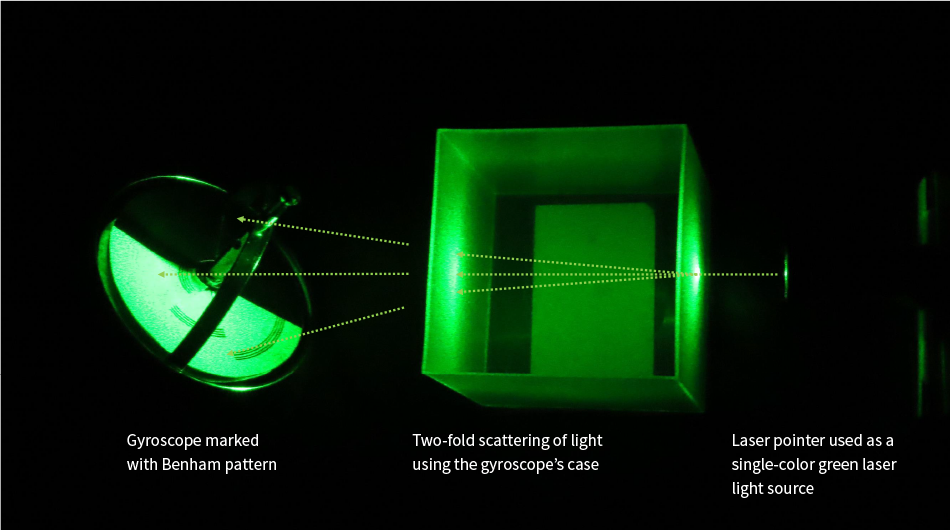 The wavelength of the light from the laser pointer was 532 nm. The diffraction pattern check performed using a compact disk shown in Figure 16 demonstrates that the light from the laser pointer does not contain light from any other parts of the spectrum.
The wavelength of the light from the laser pointer was 532 nm. The diffraction pattern check performed using a compact disk shown in Figure 16 demonstrates that the light from the laser pointer does not contain light from any other parts of the spectrum.
Figure 18—Results of Sensory Experiment in which Different Colors Can be Seen in Monochrome Light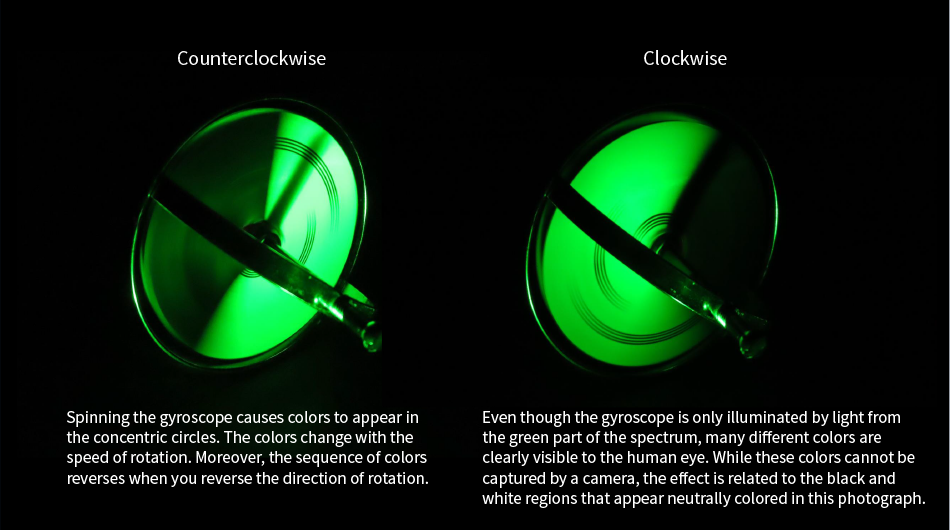 When you set the gyroscope spinning and look at the inscribed pattern, a variety of different colors are clearly visible as the gyroscope slows down, varying depending on the speed and direction of rotation (an effect confirmed by numerous people). This demonstrates how light of a single color can give rise to many different colors in the brain.
When you set the gyroscope spinning and look at the inscribed pattern, a variety of different colors are clearly visible as the gyroscope slows down, varying depending on the speed and direction of rotation (an effect confirmed by numerous people). This demonstrates how light of a single color can give rise to many different colors in the brain.
Sensory Experiment Conducted in Development of Optical Topography
When developing the idea of optical topography (OT), a technique for observing brain functions under natural conditions, I undertook a sensory experiment at home that considered the relationships between incident light applied to a human body and the resulting scattered and absorbed light.
A pointer toward this new concept came from a technique devised in the 1970s in which a laser was used for three-dimensional (3D) dynamic analysis of the radicals that form during combustion. It arose during ongoing discussions at the US National Bureau of Standards (NBS), which was located in Washington D.C. and was the forerunner of the National Institute of Standards and Technology (NIST), where our combustion research group was engaged in getting internationally standardized reference samples approved for the recently commercialized Zeeman atomic absorption spectrophotometry technique*. This led me to try shining laser light through my palm and fingers, conjecturing that, in addition to burning flames, a similar technique might also be applied to 3D measurement of the human body. In time, the MRI project would be launched (in 1982) and this instead would become the focus of work on 3D measurement of the human body. It was not until a long time later (in 1990) that I started thinking again about optical measurement.
- *
- Hideaki Koizumi, “Future of Spectroscopy,” Chemistry & Chemical Industry, The Chemical Society of Japan, (1980)
Experiments that use spectroscopy to investigate the behavior of light typically involve measurements on standard instruments in which “phantoms,” objects that absorb and scatter light, are used for quantitative purposes. For obtaining a rough and ready sense of the behavior of light, however, something like a peeled grape suspended in a multi-layered agar sweet or jelly makes for a good experimental specimen. As it turned out, after the actual experiment ultimately got underway at the laboratory much later, a carefully devised experiment was needed that involved a phantom that could serve as a reference. Normal practice at such experiments is to prepare a phantom made up of multiple layers of materials with different absorbance and scattering coefficients. This is done by forming multiple layers of liquids with precisely known absorbance coefficients or emulsions with known scattering coefficients that contain tiny polyethylene beads. A problem with this, however, is that, if a transparent divider sheet is used to prepare this layered structure, multiple reflection and scattering occurs from the top and bottom surfaces of the divider. If the multi-layer phantom is instead prepared in the same way as a jelly, however, no such divider is needed and the problem goes away.
Figure 19—Replica of Phantom Made from Japanese Sweet for Use in Optical Topography Sensory Experiment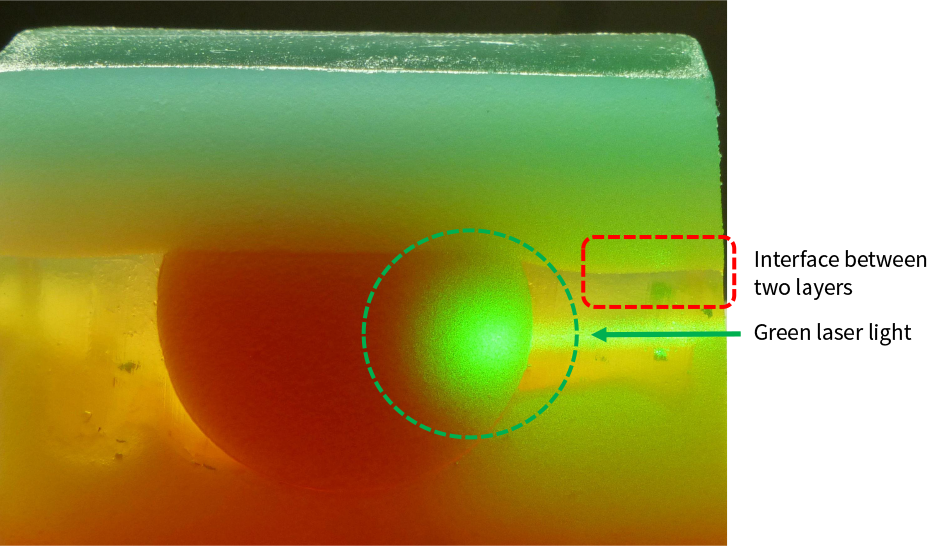 This New Year’s sweet represents the first rising of the sun from the ocean to the clouds. As the image shows, it was made using two layers of transparent gelatine with different optical properties. This means that, unlike a typical optical phantom, it has no need for a transparent sheet separating the two layers. Shining monochromatic laser light onto the sweet provides an intuitive sense of how different regions and their interfaces have different absorbance and scattering coefficients. While preparing a precise phantom for optical topography research took from six months to a year, a sensory experiment like this demonstrates that the essential elements can be completed in next to no time at all, or at least an hour or less. Urgency like this is important in research and development.
This New Year’s sweet represents the first rising of the sun from the ocean to the clouds. As the image shows, it was made using two layers of transparent gelatine with different optical properties. This means that, unlike a typical optical phantom, it has no need for a transparent sheet separating the two layers. Shining monochromatic laser light onto the sweet provides an intuitive sense of how different regions and their interfaces have different absorbance and scattering coefficients. While preparing a precise phantom for optical topography research took from six months to a year, a sensory experiment like this demonstrates that the essential elements can be completed in next to no time at all, or at least an hour or less. Urgency like this is important in research and development.
Once, when repeatedly going through this process, I happened to notice the reflection of the laser beam off a white wall. When I made a pattern by moving the beam about in pitch darkness it left behind an afterimage of complementary colors (colors that, when mixed, produce white or grey). When I then moved the beam rapidly back and forth, I also sometimes saw colors other than complementary colors. The effect is a very strange one given that the light being shone is a single sharp line spectrum laser beam. How then could I see different colors? I found it very perplexing. While I was left wondering about this for a long time, I subsequently learned about the phenomenon of subjective colors discovered a long time ago by Gustav Theodor Fechner (1801-1887). I also went on to learn about the spinning top of Charles Edwin Benham (1860-1929), which made use this effect to become popular as a toy.
The way in which my sensory experiment signifies something very different to the experiments of Fechner and Benham is that a variety of different colors are clearly visible in scattered monochrome light (light that has only a single sharp peak in its spectrum). These assorted colors appear at the lines on a Benham disk, which is comprised of black and white semi-circular regions inscribed with concentric circles broken up into separate arcs. However, when you shine a disk patterned in this way with the scattered light of a single sharp line spectrum laser beam, as shown in the figure, a series of pleasing colors appear one after another as the disk slows. Moreover, if you spin the disk in the opposite direction, the sequence in which the colors appear reverses.
I conducted this experiment at home while writing this article using only household items that were to hand on my desk. That I was able to do so can be attributed to the advances in laser technology that have made the laser pointer so ubiquitous.
Genetic diversity causes the wavelength specificity of the human retina to vary between individuals in much the same way as the widely known variations in blood type. Contrary to what you might think, the standard wavelength sensitivities are not due to having three types of receptors (cone cells) with distinctive wavelength sensitivities matching the three primary colors (red, green, and blue). While the S-cone cells (blue) do have a peak in their wavelength sensitivity spectrum at about 120 nm that is well differentiated from the M-cone and L-cone cells (green and red respectively), the corresponding peaks for red and green are close enough to be almost overlapping one another (differing by about 20 nm). What is true is that the brain is able to generate all of the different colors from what is, for all intents and purposes, just two sensitivity spectrums (the color yellow, for example, is largely a product of the brain). This means that color cannot be explained away by simple physics.
From Newton’s objectivity to Goethe’s subjectivity, the times are again moving on. This, too, is a factor in why the arts are becoming increasingly valued once more.
Closing Words of Final Article in Part 2
Although I wrote the second of these Part 2 articles to mark the 150th anniversary of the birth of Namihei Odaira, I did not touch upon Odaira’s own artistic sensibilities in that article. While the depth of his knowledge of art is clear to see in the records of his activities, primary sources are few. There is, however, reason to believe that he wanted to devote himself to an artform as a hobby just as soon as he was able to feel confident about Hitachi’s future.
Consulting what few records remain, I will here quote from Odaira’s great friend Naosaburo Takao whose writings give a different view of the man*.
- *
- Naosaburo Takao: “Recollections of President Odaira,” “Memories of Odaira-san,” Memorial Service for Namihei Odaira (1952)
(published a year after Namihei Odaira’s death)
The impression of Namihei Odaira’s distinctive sense of art, science, and technology that one takes from the sort of person he was is that he saw the essence of art and of science and technology as having an inseparable relationship with integrity.
“… Whereas the senior management of other corporations would commute by company vehicles, he would always walk from Hongo to Ochanomizu and from there take a train … For many years he made his home in a small and inconvenient house in Higashikatamachi, located among narrow backstreets that were too tight for vehicles to enter. While his home in Mikumicho was somewhat larger, after it was destroyed in the war, he settled in, for the time being, at what would be his new home in the Koishikawa annex, one that was little more than a gatekeeper’s house. However, as this place too was small, old, and impractical, it had everyone concerned and many urged him to move to a newly built home. He refused, insisting that he liked living where he was and so it came to pass that his final breath was taken in a small six-tatami room that lacked even an alcove. Thinking on things like this, I can only bow my head to him.”
These words show us Odaira’s way of thinking that focused on the essence of things rather than on appearances.
“He had a great interest in such fields as painting, calligraphy, ceramics, and architecture, and his critiques of these were always worthwhile. The first material released by his bereaved family following his death were pencil sketches from his junior and senior high school days and sketched-out watercolor paintings of scenes from his travels (which had been sealed away during his lifetime and unavailable to anyone). These are of very high quality.” This shows us someone with an interest in all aspects of the arts, not just his well-known work in photography that was at the professional level. “…He generously supported unknown oil painters and later went on to help new artists get themselves established on the scene. He had an overwhelming fondness for painters who were enthusiastic and uninterested in their own gain.” Takao further wrote that, “He was also interested in music and drama, and while he would sometimes talk about going to see a movie, I never once heard him sing, even when alcohol was being served. At one time he even told me he was thinking of learning Icchu-Bushi when he got older, but in the end that never came to pass. With all of his efforts being devoted to work, there was no time for Icchu-Bushi …”
I was especially interested to read this part about Odaira expressing a desire to learn Icchu-Bushi when he had the time. In particular, his wanting to learn this art form shows us he was someone who had a deep and sincere love for the arts. Icchu-Bushi is a type of traditional joururi (ballad drama) from the Kyoto-Osaka region popularized by Icchu Miyako-Dayu (1650-1724) who lived in Kyoto. Although not flashy, it is an extremely prestigious form of traditional Japanese performing art*.
- *Icchu-Bushi:
- Icchu Miyako-Dayu, the founder of this art form, was a contemporary of Kōrin Ogata (1658 to 1716), a painter of the Rinpa School; Monzaemon Chikamatsu (1653–1725), a kabuki and joururi author; Gidayu Takemoto (1651–1714), who founded Gidayu-Bushi; and Basho Matsuo (1644–1694), a composer of haikai poems. I was myself very moved by my first encounter with Ryochu Miyako (the head of the Icchu-Bushi School, who studied under Icchu Miyako 11 and under his own father, Icchu Miyako 12). I was able to watch and listen to the shamisen and storytelling (joururi) from up close and was left deeply impressed by the elegance and high tone of the performance. Ever since I have sought to continue my involvement as much as I can without getting in the way.
With that, I have chosen to close the final article in Part 2 with these surviving words of Naosaburo Takao that provide us with a vivid picture of Namihei Odaira’s sincere humanity and his feeling for the arts.

